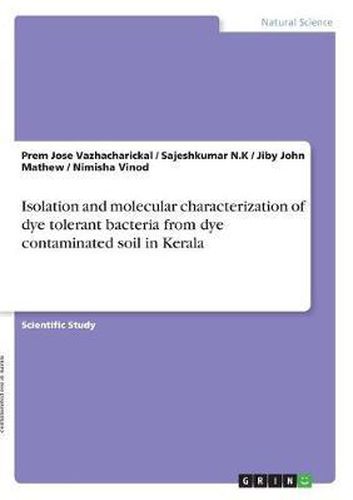Readings Newsletter
Become a Readings Member to make your shopping experience even easier.
Sign in or sign up for free!
You’re not far away from qualifying for FREE standard shipping within Australia
You’ve qualified for FREE standard shipping within Australia
The cart is loading…






Scientific Study from the year 2017 in the subject Biology - Micro- and Molecular Biology, grade: 1.5, Mar Augusthinose College, language: English, abstract: The dyes are complex chemical compounds that imparts colour to substances. On the urge of urbanisation, the use of synthetic dyes is increasing largely and its untreated effluent release causes serious environmental pollution affecting water bodies by disturbing the aquatic ecosystem, soil, plants, animals, humans. The recalcitrant nature of these dyes limits its treatment using conventional methods wherein biological methods using microorganisms are reported to completely mineralize the dyes lowering the release of degradation products. The present work focuses on the biodegradation of synthetic dyes by isolating bacteria from a dyeing unit. Soil samples from the dye contaminated soils was collected, its degradation potentiality was observed using three major dye of studies congo red, brilliant green and methylene blue within 24 hr incubation. Maximum decoloarized dye (congo red and brilliant green) were chosen, serially diluted to 10-5 and plated to obtain two distinct colonies from decolorized congo red (CR1, CR2) and three distinct colonies from decolorized brilliant green (BG1, BG2, BG3). These isolates were biochemically characterized. Molecular characterization was performed by isolating DNA from five isolates and amplified it using PCR, with the 16s rRNA gene primer. The PCR amplification product having approximately 1500bp were sequenced, edited and searched using BLAST against the known sequences within NCBI databases. The isolates were identified to be CR1 as Pseudomonas (88% identity), CR2 as Aeromonas (89% identical) and BG1/BG2 were confirmed to belong to same genus as Bacillus (99% identical). The phylogenetic tree showed a clear divergence between isolated species. Furthermore, the dye tolerance of isolates were observed by optimization analysis to be as CR1 and CR2 tolerated up to 4% of con
$9.00 standard shipping within Australia
FREE standard shipping within Australia for orders over $100.00
Express & International shipping calculated at checkout
Scientific Study from the year 2017 in the subject Biology - Micro- and Molecular Biology, grade: 1.5, Mar Augusthinose College, language: English, abstract: The dyes are complex chemical compounds that imparts colour to substances. On the urge of urbanisation, the use of synthetic dyes is increasing largely and its untreated effluent release causes serious environmental pollution affecting water bodies by disturbing the aquatic ecosystem, soil, plants, animals, humans. The recalcitrant nature of these dyes limits its treatment using conventional methods wherein biological methods using microorganisms are reported to completely mineralize the dyes lowering the release of degradation products. The present work focuses on the biodegradation of synthetic dyes by isolating bacteria from a dyeing unit. Soil samples from the dye contaminated soils was collected, its degradation potentiality was observed using three major dye of studies congo red, brilliant green and methylene blue within 24 hr incubation. Maximum decoloarized dye (congo red and brilliant green) were chosen, serially diluted to 10-5 and plated to obtain two distinct colonies from decolorized congo red (CR1, CR2) and three distinct colonies from decolorized brilliant green (BG1, BG2, BG3). These isolates were biochemically characterized. Molecular characterization was performed by isolating DNA from five isolates and amplified it using PCR, with the 16s rRNA gene primer. The PCR amplification product having approximately 1500bp were sequenced, edited and searched using BLAST against the known sequences within NCBI databases. The isolates were identified to be CR1 as Pseudomonas (88% identity), CR2 as Aeromonas (89% identical) and BG1/BG2 were confirmed to belong to same genus as Bacillus (99% identical). The phylogenetic tree showed a clear divergence between isolated species. Furthermore, the dye tolerance of isolates were observed by optimization analysis to be as CR1 and CR2 tolerated up to 4% of con